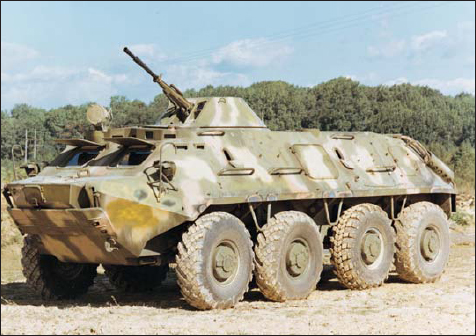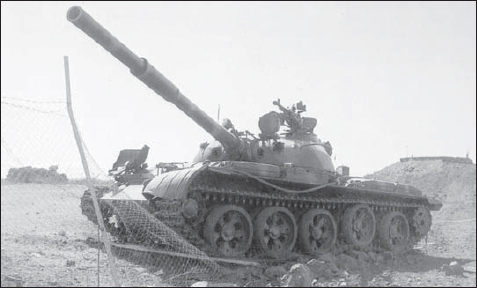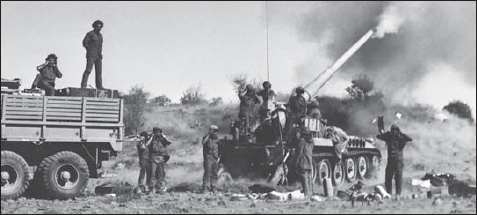
Identified Syrian formations on the Golan front were, from north to south, as follows: in the foothills of Mount Hermon was a Moroccan brigade; to the north of the Kuneitra–Damascus road was the 7th Infantry Division with an attached armoured brigade; south of the road and with a front extending from Kuneitra to just north of Rafid was the 9th Infantry Division, also with an attached armoured brigade; south and east of Rafid and north of the Yarmouk Valley was the 5th Infantry Division with a reinforced tank component and an attached armoured brigade. Behind these formations was a second echelon: 3rd Armoured Division deployed between Katana, its permanent camp, and Sasa; 1st Armoured Division south and west of its permanent base of Kiswe.
A Syrian infantry division contained the following main combat elements: one infantry brigade, two mechanised infantry brigades, and one armoured brigade. The infantry and mechanised infantry brigades had three infantry battalions, a battalion of 40 tanks (T-54s or T-55s) and a field artillery battalion. The armoured brigades fielded three 40-tank battalions. Other components of a Syrian infantry division included regiments of field and anti-aircraft artillery, a reconnaissance battalion and a chemical warfare company. Syrian brigades of all types had a troop of four PT-76 reconnaissance tanks per company and another for each battalion and brigade HQ.

The Syrian Army also employed the eight-wheeled BTR-60 APC in significant numbers. This model is the BTR-60PB with an enclosed turret housing a 14.5mm KPVT heavy machine-gun and a co-axial 7.62mm PKT.
These units gave the division a strength on paper of some 10,000 men, 200 tanks, 72 artillery pieces and approximately the same number of anti-aircraft guns and SAMs. The real figures at the beginning of October were, however, markedly different. Only the 5th Infantry Division had its full complement of armoured and mechanised vehicles; the 7th Infantry Division had only 80 per cent of its tanks and APCs and in the case of 9th Infantry Division the figure dipped to 50 per cent. Nevertheless, the designation ‘infantry’ is misleading, as these Syrian infantry divisions were essentially mechanised formations.
However, both Syrian armoured divisions, 3rd and 1st, were at full strength. Each of their two armoured brigades contained 120 tanks and, with a mechanised infantry brigade, they could put more than 250 tanks into the field with the same supporting units as an infantry division. For the attack on the Golan, Syrian forces numbered some 60,000 men, 1,400 tanks and 800 guns.
Cabinet & GHQ
Hafaz al Assad, President of Syria
Major General Mustafa Tlas, Minister of Defence
Major General Youssef Chakkour, Chief of Staff
Major General Abdul Razzaq Dardary, Chief of Operations
Major General Jibrael Bitar, Director of Intelligence
GHQ Forces
Assad Republican Guard Armoured Brigade
30th Infantry Brigade
90th Infantry Brigade
62nd Independent Infantry Brigade
88th Armoured Brigade
141st Armoured Brigade
1st Commando Group
82nd Parachute Battalion
Desert Guard Battalion
Western Syria
Latakia – Infantry Brigade
Homs – Infantry Brigade
Aleppo – Infantry Brigade
+ Moroccan Expeditionary Brigade
+ Saudi Arabian 20th Armoured Brigade (King Abdul Aziz Brigade)
+ Two commando brigades of the Palestinian Liberation Army
1st Armoured Division – Colonel Tewfiq Juhni
4th Armoured Brigade
91st Armoured Brigade
2nd Mechanised Infantry Brigade
64th Artillery Brigade
3rd Armoured Division – Brig Gen Mustafa Sharba
20th Armoured Brigade
65th Armoured Brigade
15th Mechanised Infantry Brigade
13th Artillery Brigade
5th Infantry Division – Brigadier General Ali Aslan
12th Infantry Brigade
61st Infantry Brigade
132nd Mechanised Infantry Brigade
50th Artillery Brigade
47th Independent Armoured Brigade (attached)
7th Infantry Division – Brigadier General Omar Abrash2
68th Infantry Brigade
85th Infantry Brigade
1st Mechanised Infantry Brigade
70th Artillery Brigade
78th Independent Armoured Brigade (attached)
9th Infantry Division – Colonel Hassan Tourkmani
52nd Infantry Brigade
53rd Infantry Brigade
43rd Mechanised Infantry Brigade
89th Artillery Brigade
51st Independent Armoured Brigade
Iraqi Forces
3rd Armoured Division – Brigadier General Lafta
6th Armoured Brigade
12th Armoured Brigade
8th Mechanised Infantry Brigade
+ Artillery Group
Jordanian Forces
40th Armoured Brigade – Brigadier Haled Hajhouj al Majali

The most powerful tank in the Arab armies during the October War was the T-62 with its formidable 115mm main armament and automatic loading system. Although it had been encountered before the October War, the T-62 came as a rude shock to the Israelis as did the tenacity and determination of the Syrian crews who continued to attack despite appalling casualties.
The Syrian Air Force, commanded by Major General Maji Jamil, had over 300 aircraft, including 30 Su-7 and 80 MiG-17 ground-attack aircraft, 200 MiG-21 interceptors and a small number of Il-28 light bombers. However, mindful of the mauling it had received at the hands of the IAF on 13 September, the Syrians, like the Egyptians, integrated the air force with the SAM air defence system for the coming attack. West of Damascus they deployed about 100 SAM batteries and, in addition to divisional AA weapons, some 30 anti-aircraft companies equipped with 160 guns, many of them ZSU-23-4 multi-barrelled, self-propelled anti-aircraft cannon.
Against the formidable Syrian forces assigned to the attack on the Golan Heights, the Israelis deployed just a single under-strength armoured brigade, two infantry battalions and four batteries of self-propelled artillery. The reason for this alarming imbalance was simple – the Israelis did not believe the Syrians would attack without Egyptian co-operation and the Egyptians would not go to war for at least another three years. This was the received wisdom of the Israeli intelligence community and nothing would change this perception. Any Syrian incursion would be met by the full force of the mighty Israeli Air Force that had paved the way for the stunning victory in 1967. By 1973, the air force absorbed 52 per cent of the Israeli defence budget and the other combat arms were being starved of resources accordingly, particularly the infantry and the artillery branches. The infantry were equipped with outmoded personal weapons and the venerable M3 Halftrack remained the principal battlefield transport as the M113 APC [Armoured Personnel Carrier] had been procured in relatively small numbers. Worse still the artillery had only a limited number of modern self-propelled guns such as the M107, M109 and M110. It was the role of the air force to provide fire support to the ground troops and pound the enemy to destruction while the formidable Israeli fighters provided complete air superiority over the battlefield.
Thus the resident garrison on the Golan supported by the overwhelming firepower of the air force was deemed to be sufficient deterrent to invasion and more than adequate to counter any limited incursion. If war seemed imminent, the intelligence services would give at least 48 hours notice during which time the well-oiled wheels of mobilisation would be set in motion with reserves arriving at the front as war broke out. Reserve divisions would then be deployed to each of the fronts depending on the situation, be it Northern Command facing Lebanon and Syria; Central Command bordering Jordan and Southern Command in the Sinai against the Egyptians. Such was the theory but the Arabs had devised a counter to all these measures. The stage was set for war.

The Israeli Artillery Corps was very much the poor relation of the IDF’s various branches prior to the October War as, according to Israeli doctrine, it was the task of the air force to provide the majority of the fire support to the ground troops on the battlefield. As a result, there were too few self-propelled artillery batteries equipped with modern weapons such as this 175mm M-107 gun bombarding Syrian positions.
Cabinet
Mrs Golda Meir, Prime Minister
General Moshe Dayan, Minister of Defence
Israel Defense Forces GHQ
LtGen David ‘Dado’ Elazar, Chief of Staff
MajGen Israel ‘Talik’ Tal, Deputy Chief of Staff
MajGen Eliezer Ze’ira, Chief of Intelligence
Northern Command Central Command Southern Command
MajGen Yitzhak ‘Haka’ Hofi
Ugda Raful (36th Armoured Division) – BrigGen Rafael ‘Raful’ Eitan
188th Armoured Brigade ‘Barak’ – Col Yitzhak Ben Shoham
7th Armoured Brigade – Col Avigdor ‘Yanush’ Ben Gal
1st Infantry Brigade ‘Golani’ – Col Amir Drori
31st Parachute Brigade – Col Elisha Shelem
Ugda Laner (240th Reserve Armoured Division) – BrigGen Dan Laner
17th Reserve Armoured Brigade – Col Ran Sarig
679th Reserve Armoured Brigade – Col Uri Orr
+ Elements of the Barak Brigade from 7 October
Ugda Musa (146th Reserve Armoured Division) – BrigGen Moshe ‘Musa’ Peled
4th Reserve Armoured Brigade – Col Ya’akov ‘Pepper’ Hadar
9th Reserve Armoured Brigade – Col Mordechai Ben Porat
70th Reserve Armoured Brigade – Col Gideon Gordon
205th Reserve Armoured Brigade – Col Ben Yossi Peled
1 Source: Elusive Victory – The Arab-Israeli Wars 1947–1974 by Colonel Trevor Dupuy, Macdonald and Jane’s, London 1978
2 Killed in action on 8 October 1973. He was replaced by Brigadier General Said Berakdar